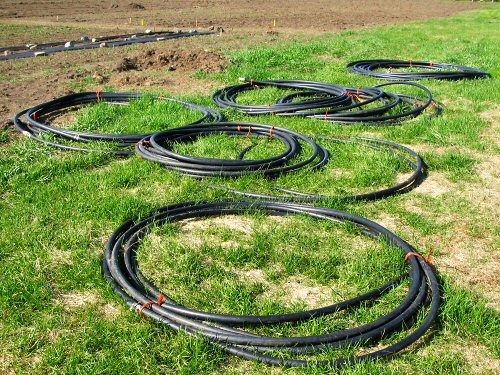
A bonus this spring has been the steady rain, not too frequent, like, once a week or so, and somewhere around 1″ (2.5cm) each time. Perfect! Still, today, in the middle of a hot, sunny stretch, thoughts turned to water (not that it was ever far from mind). Out came the coils of 1″ water pipe. In our barebones spot irrigation system, there’s 1″ pipe and a bit of 2-1/2″ pipe, endless 5/8″ garden hose and 50′ sections of soaker hose, the gas-powered irrigation pump, and even 55-gallon barrels and watering cans. Not to mention, piles shut-off valves, quick connectors, and various hose fittings. For now, all that I’m looking to set up is one central line running from the well pump at the house, right down the length of the side-by-side fields, where it can feed the garden hoses. So, uncoiling we go…




Mike:
When you are running the pump, how are you controlling pressure, so you aren’t blowing out the soakers or drip irrigation lines. I’ve only used a gas pump with a set throttle with overhead sprinklers. You could throttle the pump to make the pressure work for the situation.
I’ve been pondering this as I’d like to use all drip/t-tape with a gas pump for cost, but have been thinking I’d have to go electric or battery pump with a pressure tank in order to operate within the lower PSI and gph of the drip lines. Does the gas pump slack off when operating pressure is achieved?
Thanks,
Mike
Interesting entry, Mike. It was a lot more meaningful to me since I’m installing a drip irrigation system in my largish garden. I’m no plumber so I’ve made a number of runs to our local hardware store for advice, information, and parts. Some of the advice was bad – leading to my buying parts I did not need – and some of it was good from the one guy in the store who really knew what he was talking about. I’m learning a little about plumbing rapidly. But the mainline is finally in place and without leaks. Now on to the emitter lines and shut-off valves…
i am not familiar with irrigation systems, so i was wondering doesn’t those closer to the pump get more water than the ones at the end of the line?
This is certainly a nifty system you’ve designed here! I haven’t seen anything quite like it. How long did a project like this take to complete? Have you been receiving satisfactory results from it? Anyway, keep developing those ideas. ;) Nice work.
For a drip system, you need to have a pressure regulator in line, this will keep everything constant.
Homemoma,
The regulator will mean that the drippers at the far end of the pipe will release the same ammount as those closer to the pump.
Also required.. a filter, this is going to save a lot of hassle, a non return valve to stop back syphoning,
Its also a very good idea to be able to flush the system out by opening the far end of all of your pipes. This need to be done regularly, its amaxing how the crapola can get in and it will block your drippers, any dirt on the drippers can get sucked back into the pipe
http://www.youtube.com/watch?v=fUOYG22tFSU
hey Tiny Farm,
Here’s a little something different for you agricultural types! It’s the Irrigation Song I wrote while on tour and passing through the long state of Kansas. Best, Sarah Donner
Great article. Remember, filtration is vital to a good drip system. Drip can solve many water shortage issues and many companies are pushing drip, especially subsurface drip with great success. Subsurface drip tape is used extensively for tomato, cotton and alfalfa production.
Thank you!!! drip systems saved my mom a lot of headache. last year we had one installed in her backyard and its saved me a lot of time since Im responsible for keeping up on the house now. Im facing some big projects coming up here now that the whole house is being left to me. I enjoy reading up on blogs you get great ideas online here.